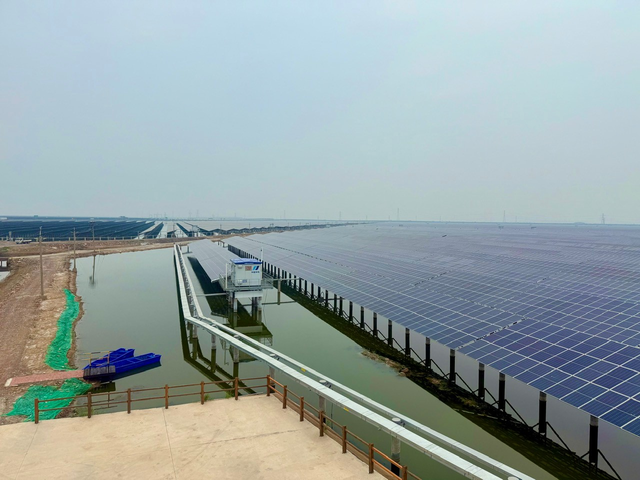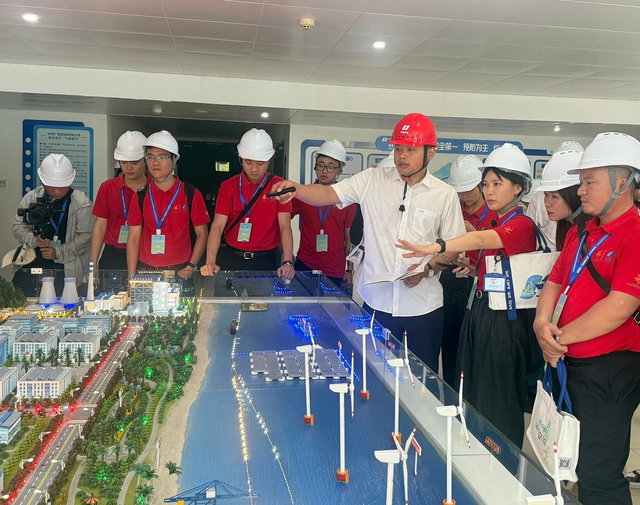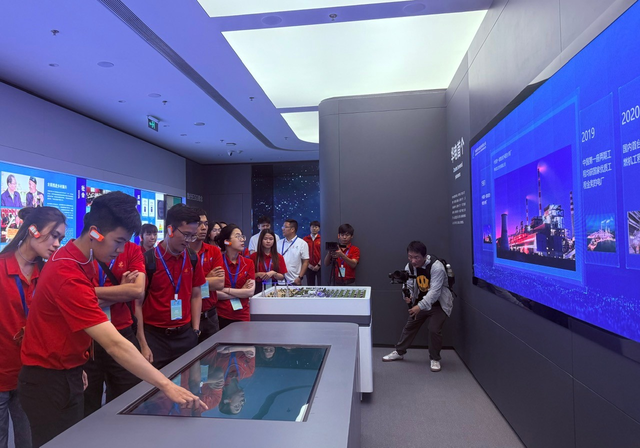
Red study tour: Exploring China’s ‘energy factories’
The dual carbon goals—reducing carbon dioxide (CO2) emissions and achieving net-zero emissions—along with the global push toward green energy in the power sector are key themes drawing the attention of Vietnamese youth participating in the Red Study Tour.
From June 22 to 29, young representatives from Vietnam’s power sector visited modern power plants in China, witnessing first-hand advanced scientific and technical applications as well as innovative renewable energy technologies.
A green energy trend
This trip offered the Vietnamese youth a valuable opportunity to engage directly with a variety of power generation models—from conventional to cutting-edge.
Especially impressive were China’s large-scale renewable energy projects.
One highlight was a visit to the Hai Qing Salt-Solar Hybrid Project in Tianjin—currently the world’s largest salt-electricity integration project.
The project generates about 1.5 billion kWh of green electricity annually.
According to staff on site, the project plays a critical role in securing Tianjin’s green energy supply, saving approximately 500,000 metric tons of standard coal each year.
It employs a ‘three-in-one’ model: solar power generation on the water surface, salt production on the water, and aquaculture beneath it—supporting ecological harmony while actively contributing to China’s ‘dual carbon’ strategy.

The world’s largest salt-electricity hybrid project. Photo: Hong Phuong
Another key stop was the Jiangnan Distributed Energy Station operated by Nanning Huadian New Energy Co., Ltd.
This facility illustrates the shift from centralized, fossil-fuel-based energy systems to distributed systems powered by renewables.
It is a clear example of the growing role of distributed energy technologies (DET) in the evolving energy landscape.
Participants gained insights not only into technical solutions but also into how these technologies support the development of a more sustainable and efficient energy infrastructure.

The Vietnamese youth delegation visits the Jiangnan Distributed Energy Station. Photo: Hong Phuong
The delegation also toured exhibitions and watched presentations by China Huadian Corporation (CHD) and Huadian Engineering Company (CHEC), gaining insights into the latest technological applications and green energy developments in China’s power sector.
“Huadian Engineering Company has leveraged its industrial clusters, resource advantages, and technological expertise to launch diverse investment activities—from overseas power engineering to domestic clean energy, urban water systems, environmental protection through BOT projects, and more—creating new engines for growth,” explained Wang Yifeng, deputy Party secretary of Huadian Integrated Smart Energy Technology Co., Ltd.
Another notable visit was to the Shilongba Hydropower Plant in Kunming—China’s first hydroelectric plant.
Beyond being a power-generating facility, it also serves as a national industrial heritage site and a living museum of hydropower history.
Hands-on exchange and learning
The energy industry is undergoing a major transformation, driven by digital innovation and green development goals.
In this transition, digital technologies and artificial intelligence (AI) are playing a crucial role in enhancing efficiency, safety, and sustainability.

The Vietnamese youth delegation visits China Huadian Group. Photo: Hong Phuong
In Vietnam, EVN (Vietnam Electricity) and its subsidiaries are also adopting similar technologies, including SCADA systems, smart meters, AI-powered equipment diagnostics, and software for monitoring grid operations—improving maintenance quality and grid reliability.
“I hope this journey will lead to more opportunities for collaboration, learning, and experience-sharing between young people in Vietnam and China. I also hope Duyen Hai 2 Thermal Power Plant and other energy companies will soon apply advanced AI solutions to support Vietnam’s green transition and sustainable energy development,” said Huynh Minh Nhut, senior thermal control maintenance technician at Duyen Hai 2 Power Plant.
Following visits to China’s energy facilities and flagship green projects, the Vietnamese delegation gained not only technical knowledge but also meaningful interpersonal connections.
Exchanges with Chinese youth sparked the sharing of ideas, broadened perspectives, and strengthened friendship between the two nations.
According to Pham Xuan Minh Tri, secretary of the Ho Chi Minh Communist Youth Union chapter at EVN, the Red Study Tour enabled EVN’s youth to witness China’s progress—especially in energy development—first-hand.
It opened new doors for learning about project investment, technology application in grid management and operations, and the training of a high-quality workforce.
EVN expressed its hope that CHD would continue to build on its strengths and achievements in China while supporting Vietnam in advancing science and technology to ensure energy security—especially in the clean energy sector—for a more sustainable future.
Bao Anh - Hong Phuong / Tuoi Tre News
Link nội dung: https://news.tuoitre.vn/red-study-tour-exploring-chinas-energy-factories-103250702190523234.htm